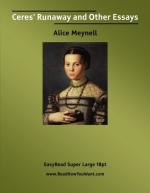The novelist would be at a loss had we a number of such years. He would lose the easiest landscape—for the autumn has among her facile ways the way of allowing herself to be described by rote. But there were no regions of crimson woods and yellow—only the grave, cool, and cheerful green of the health of summer, and now and then that deep bronzing of the leaves that the sun brought to pass. Never did apples look better than in those still vigorous orchards. They shone so that lamps would hardly be brighter. The apple-gathering, under such a sun, was nearly as warm and brilliant as a vintage; and indeed it was of the Italian autumn that you were reminded. There were the same sunburnt tones, the same brown health. There was the dark smile of chestnut woods as among the Apennines.
For it was chiefly within the woods that the splendid autumn without pathos gave delight. The autumn with pathos has a way there of overwhelming her many fragrances in the general odour of dead leaves generalized. That year you could breathe all the several sweet scents, as discriminated and distinct as those of flowers on the tops of mountains—warm pine and beech as different as thyme and broom, unconfused. Even the Spring, with her little divided breezes of hawthorn, rose, and lilac, was not more various.
Moreover, while some of the woods were green, none of the fields were so. In their sunburnt colours were to be seen “autumn tints” of a far different beauty from that of a gaudy decay. Dry autumn is a general lover of simplicity, and she sweeps a landscape with long plain colours that take their variations from the light. When the country looks “burnt up,” as they say who are ungrateful for the sun, then are these colours most tender. Grass, that had lost its delicacy in the day when the last hay was carried, gets it again. For a little time it was—new-reaped—of something too hard a green; then came dry autumn along, and softened it into a hundred exquisite browns. Dry autumn does beautiful things in sepia, as the water-colour artist did in the early days, and draws divine brown Turners of the first manner.
The fields and hedgerows must needs fade, and the sun made the fading quick with the bloom of brown. For one great meadow so softly gilded, I would give all the scarlet and yellow trees that ever made a steaming autumn gorgeous—all the crimson of the Rhine valleys, all the patched and spotted walnut-leaves of the muhl-thal by Boppard, and the little trees that change so suddenly to their yellow of decay in groups at the foot of the ruins of Sternberg and Liebenstein, every one of their branches disguised in the same bright, insignificant, unhopeful colour.
An autumn so rare should not close without a recorded “hail and farewell!” Spring was not braver, summer was not sweeter. That year’s great sun called upon a great spirit in all the riverside woods. Those woods did not grow cold; they yielded to their last sunset.




